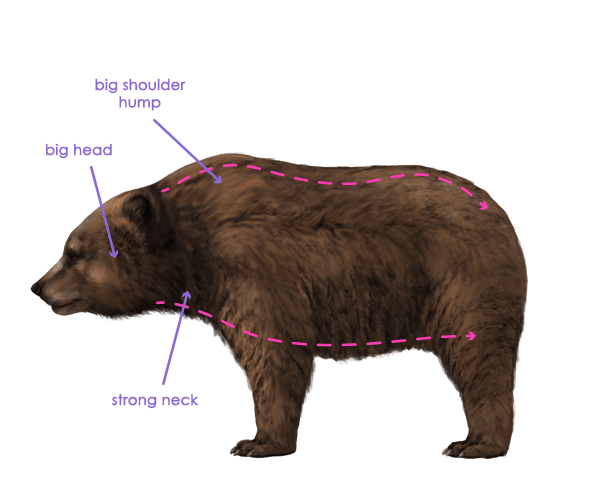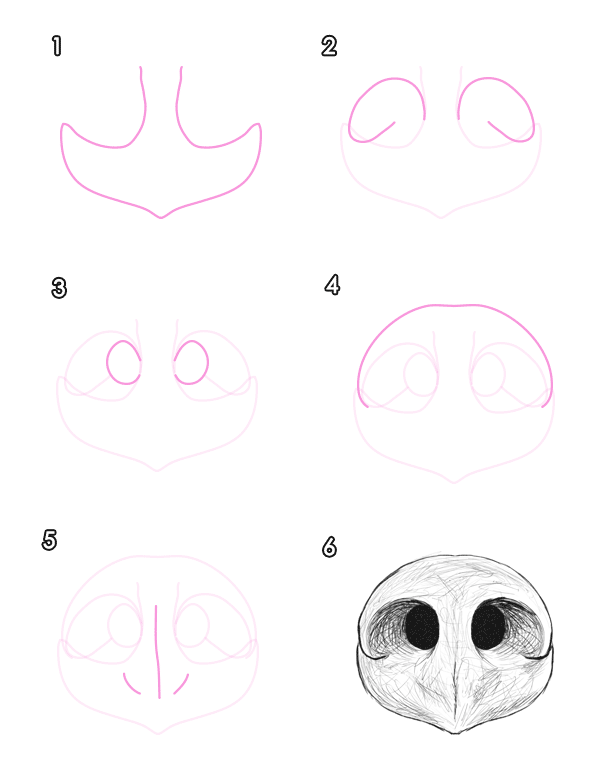
Bears are different from cats or dogs, so they aren’t be drawn as intuitively. I can show you how to draw four of the most popular bears in a quick and realistic way. Ready to learn?
1. General Anatomy: Skeleton and Muscles
Step 1
As usually, we’ll start with the skeleton. As you may notice, it differs from other animals we have been learning about. Just look at the hind legs: while a lot of animals walk on their toes, bears use all of their “hands” and “feet” to walk. It means they’re built almost like humans! That’s why they can stand on their hind legs so easily, while cats and dogs do it very unstably.

Step 2
Let’s simplify the skeleton to see the proportions better.

Step 3
Bears are generally covered with thick fur that hides the lines of muscles, but if you want to draw your bear in an exaggerated style (for example, to show its strength), it’s good to stress the muscles.

Step 4
However, most of the time all you’ll need will be the scheme below – you can easily cover it with fur afterwards, hiding all the muscle-work you actually haven’t done.

2. Bear Species: Silhouette Comparison
Before we draw a pose for any bear, we need to pick a particular species. We’re going to discuss four of them: brown bear, polar bear, black bear and giant panda.
Step 1
The brown bear is a general name for a few subspecies that are almost identical, but live in different areas. For example, grizzly is a brown bear from North America.
When drawing a brown bear, remember about it’s distinctive shoulder hump and big, strong body. The head and neck are large, and the claws are long and light in color. The fur is thick and creates visible bunches.

Step 2
Polar bears have very characteristic, streamline silhouette. The head is small and streamline too, attached to long, tapered neck. The paws are wide, with short, dark claws. White fur may get creamy yellow with age.

Step 3
Black bears are medium sized, smaller than brown bears, but the size and color aren’t the only differences. You can notice the lack of shoulder hump and that the back is going up, not down.

Step 4
Giant pandas are bears too, although they don’t like meat at all and they’re quite peaceful. Pandas are also the easiest to draw – just create a rounded, tubby barrow, short neck and big head, and with correct colors you’ll have a realistic panda in no time!

Step 5
You can use the scheme below to learn the main differences in the bear silhouettes.

Step 6
Now pick a bear and draw a pose for it using features from this step. I’ve chosen a polar bear with a little cub riding on its back. As you can see here, bears have pacing gait, they use legs from one side of the body for every step.


3. Draw a Bear’s Head
Although all bears have similar skulls, there are very important differences you need to keep in mind when drawing a bear.
Step 1
- Brown bears have big heads with distinctive forehead and small eyes;
- Their ears are big, round and fluffy;
- The nose is slightly protruding;
- There’s a visible mane starting under the chin and going across the neck.

Step 2
- Polar bears have tapered heads with very small eyes;
- The ears are small, fluffy, and can be “closed” when a bear is swimming underwater;
- The top of the mouth isn’t that heavily covered with fur – a greyish shade and whisker holes are visible under it.

Step 3
- Black bears have a distinctive light-colored muzzle and rottweiler-like patches over the eyes;
- The ears are round and big;
- The eyelids are visible, not completely covered with fur.

Step 4
- Giant pandas have round heads almost merged with necks;
- The muzzle is short and rounded;
- Ears are big and round;
- The eye-patches make the eyes seem giant from distance, but they’re in fact quite small.

Step 5
Now you can draw a head for your bear:




5. Head Details: Eyes, Ears, Nose
Step 1
Bear eyes differ among species, but they’re generally round, dark (brown or hazel) and small. You can draw them using the method shown below:

Step 2
A bear’s nose is quite similar to a dog’s:
- Start with an anchor;
- Add loose spirals on it;
- Add nostrils;
- Draw a dome covering all the upper part;
- Add details;
- Polish things up!

Step 3
Cute, round ears of teddy bears aren’t really exaggerated, bears’ ears look just like this! I guess there isn’t much to explain – start with a circle and cover it with fur.

Step 4
Here’s my picture with the head details added:

5. Draw Bear Paws
Step 1
As we noticed before, bears are built similarly to humans. Their paws also confirm this fact – bears have five fingers and familiar shape of the feet.

Step 2
When drawing forepaws, you can base the bear on the toes only or whole hands. Below you can find a method for the first way:

Step 3
The second method can be used for hind paws too. When drawing all the feet laying flat, remember to add a bit longer heel to the feet!

Step 4
This is how I added paws to my bears:






6. Fur Distribution
Step 1
Fur of a bear is so thick that it doesn’t really let you draw any muscle lines. How to make the body more realistic then? Use fur to create the lines of the body!

Step 2
And here’s the effect in practice:

Awesome Work, You’re Done!
Now you know how to draw the most popular species of bear. Isn’t it cool? But that’s just the beginning – there are so many other animals waiting to be drawn! Check out my series How to Draw Animals to learn more. Good luck!

{excerpt}
Read More